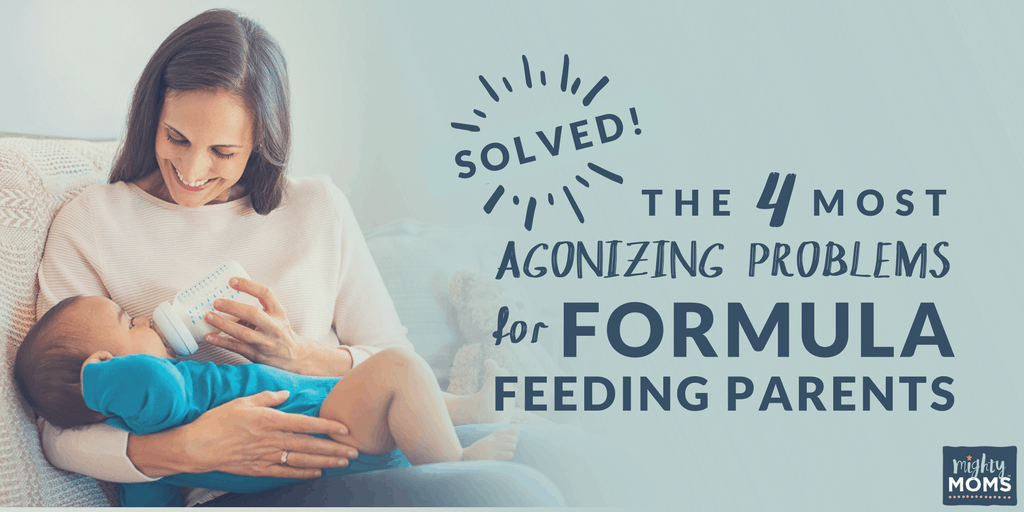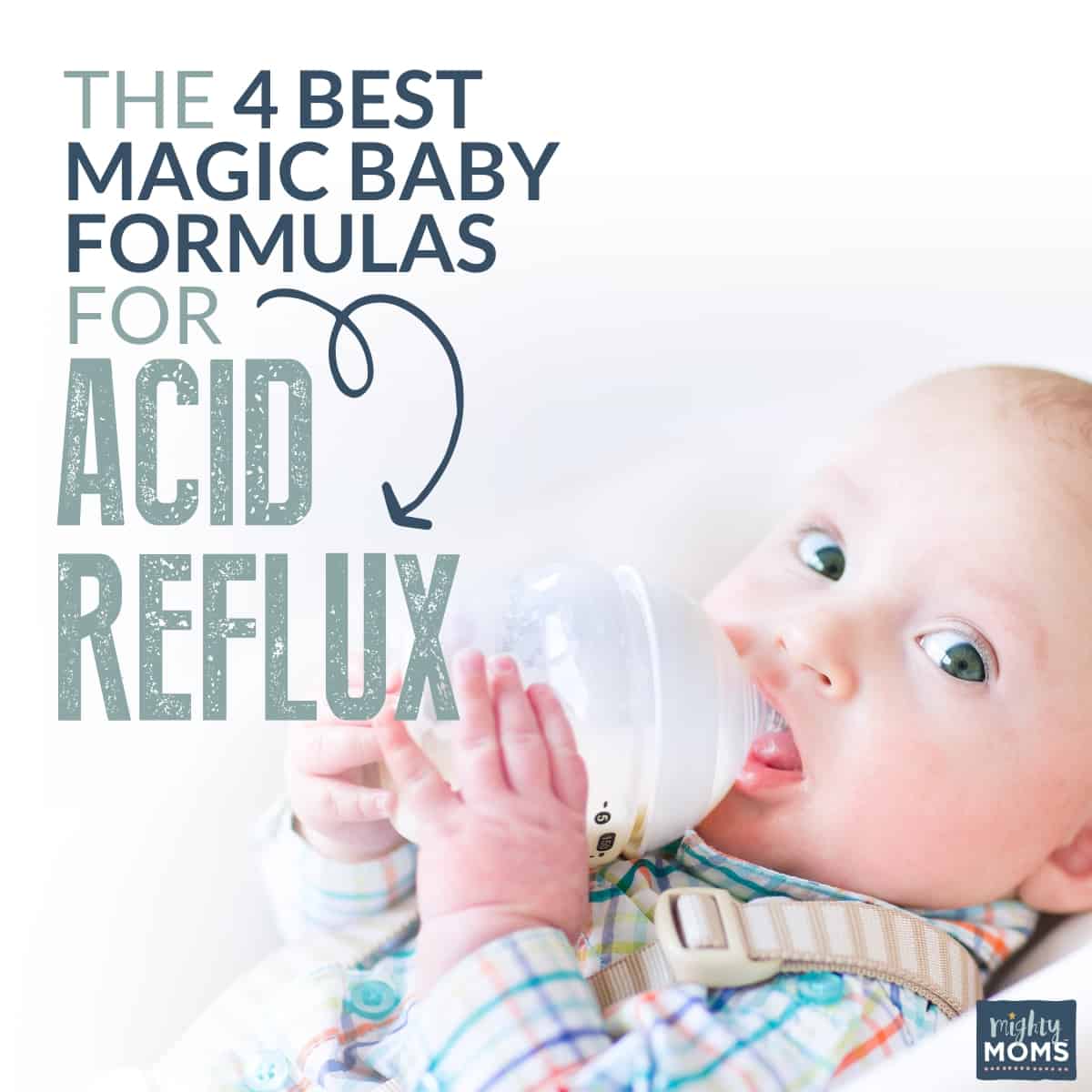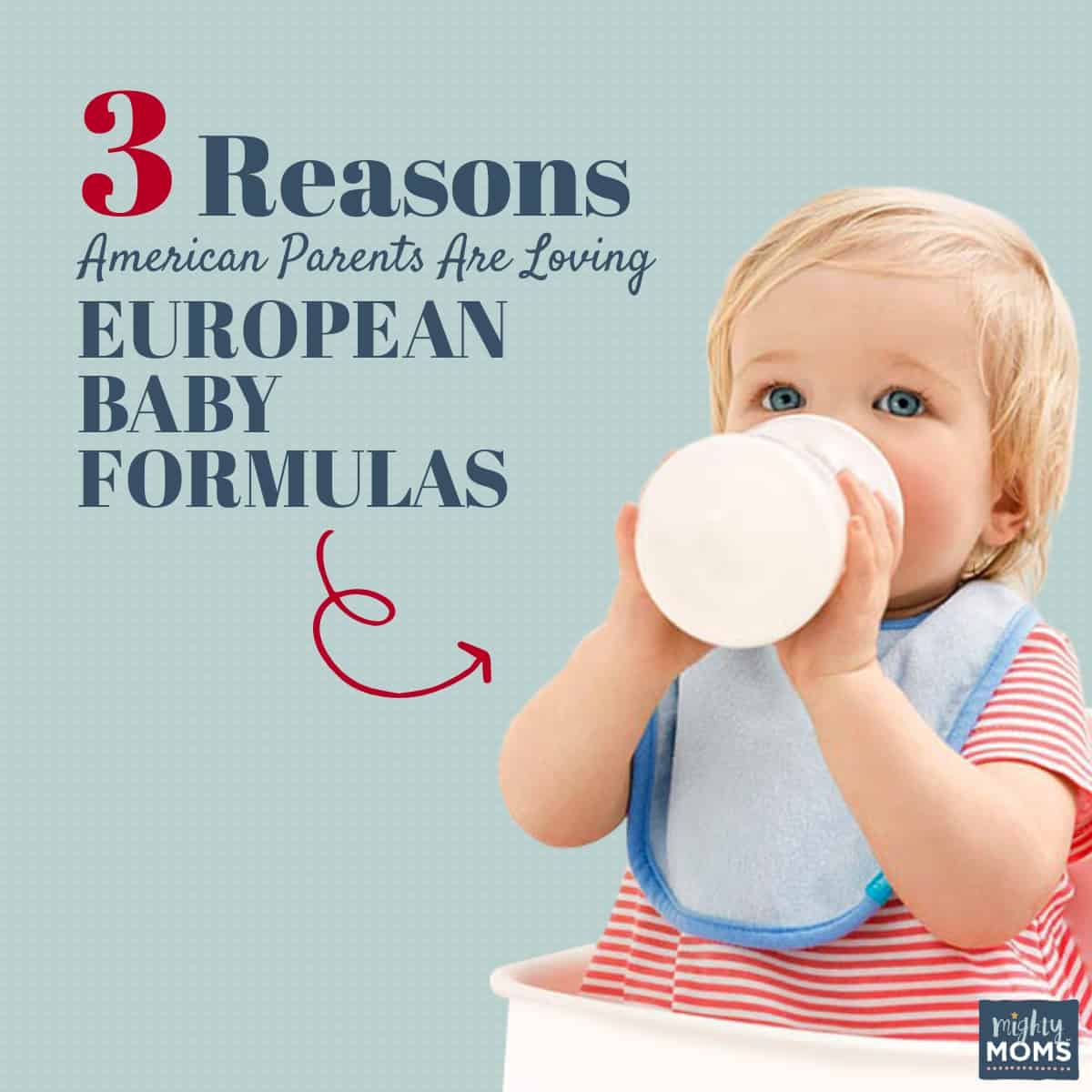In This Article...

Today I’m going over the four hardest problems for formula feeding parents. We’re going to take each of them out of the box and look them over.
By the time you finish reading this, you’re going to feel the gentle reassuring breeze of mom-confidence blowing your way.
Problems for Formula Feeding Parents #1: Are We Second-Class Parents?
Breast is best.
I hate that phrase.
Not because it’s isn’t true. It IS true. Technically. From a simple nutritional perspective, breastmilk is the perfect food for your baby.
No, my problem with the phrase “Breast is best,” isn’t the phrase, it’s how that phrase is used.
Oftentimes there’s an agenda dangling unspoken from the other side of the period: “Breast is best. (And shame on you if you don’t give THE BEST to your baby…)”
It just feels too simple. Like you’re looking at life as a black-and-white photo where everything can be categorized into “Best” and “Worst.” But life is more like a Picasso than a paint-by-numbers project. It’s a beautifully complicated mess of colors that can take a while to “get.”
Sometimes breastfeeding fits the life-painting perfectly. Sometimes it doesn’t…and that’s okay.
If one of your biggest problems for formula feeding is feeling guilty, ask yourself three questions:
- Are you feeding your baby on a regular basis?
- Is your doctor comfortable with what you are feeding your baby?
- Are you meeting your baby’s physical and emotional needs?
These are the questions that really matter. If you can answer YES! to all three of those questions, everything else is gravy. 🙂
Problems for Formula Feeding Parents #2: Did We Choose the Wrong Formula?
Once you’ve gotten past the emotional hurdles of using baby formula, the next hurdle in struggling through the most common problems for formula feeding parents is whether or not you’ve chosen wisely (to quote Indiana Jones and the Last Crusade).
As Lewis Carroll advises, the best place to start anything is at the beginning. Ask yourself a few basic questions.
How Important is “Organic” to You?
The problem with formula feeding an organic formula, though, is that there are so many organic options. I’ve found the clearest standard of the word “organic” is to steal from the Europeans.
Europe practices Biodynamic Organic Farming, which is like organic farming on steroids. (All natural steroids, of course.)
- The entire ecosystem of the farm is considered and maintained: soil, seeds, plants, animals, and humans.
- No pesticides or chemical fertilizers are used in the soil. (Just nature’s favorite fertilizer, poo.)
- There is no genetic modification of plants or animals (GMO’s).
- Certain processing practices (or ingredients) are also prohibited.
The best place for Americans to purchase European baby formulas is Organic Baby Formula 24. They have a stellar reputation and can ship your order in bulk, saving you a lot of American dollars.
Are You On a Tight Budget?
If you are concerned about the impact of your baby’s formula on your budget, the best way to save money is to purchase standard formulas like Similac Total Comfort in bulk on Amazon and have it auto-shipped.
Buying formula in bulk can save a lot of money in the long term.
Does Your Baby Have a Sensitive Tummy?
One of the most common problems for formula feeding is digestion. Truth is, every formula has a specific, well, formula for putting together the carbs, proteins, micronutrients and fats your baby needs to grow healthy and strong.
Your infant’s digestion will either give you a happy bubbly baby or an inconsolable screamer. Acid reflux, constipation, and gassiness are your worst enemies when it comes to contentment and sleep.
If your previous babies struggled with these issues, or if a family history makes you suspect it’s on the horizon, you may want to consider trying a free sample of Kabrita’s Goat Milk Formula. Formulas adapted from goat’s milk (instead of cow’s milk) have been shown to form a lighter curd in the stomach, making digestion a LOT easier.
Plus, many parents have reported that their children preferred the naturally sweeter taste of goat’s milk. Click here and try it for free.
If organic is important to you, give Holle Goat Milk Formula a try.
Problems for Formula Feeding Parents #3: When Should We Try a New Formula?
Once you’ve chosen the baby formula to try, the very next thought that’s going to flit through your head is inevitably: Would things be better if I switched to a different formula?
Some babies will happily drink anything, with hardly any unpleasant side effects. Other babies though, they’re like that food critic in Ratatouille: a Mr. Grumpy Pants who hates 99% of everything. The challenge is to find that mysterious 1% that fits him perfectly!
Here are the signs that a formula switch may be on your horizon:
- Draws legs into the tummy and cries really hard until passes gas.
- Is constantly constipated – the poop is thicker than peanut butter
- Burps or passes gas ALL the time
- Is much fussier than normal and has a strange rash (could be a formula allergy!)
- Spits up after almost every meal (check for acid reflux)
- Projectile vomits (shoots like a hose)
- Is fine after eating, but will wake up screaming or gets really fussy about 20-30 minutes after eating.
Keeping a Feeding Journal
As you’re feeding him, jot down how much he’s eating, when, and any “side effects” later on. (Don’t worry, this isn’t forever! Just for a few weeks as you test out the formula.)
This feeding diary is very important for three reasons:
- Especially if you have a newborn, your doctor is going to want to know exactly how much he’s eating. You won’t just “remember.” Trust me. Your exhausted brain is tired. Write it down.
- Logging helps you spot rhythms and patterns to your day. These important clues can help you figure out why he’s crying.
- Tracking what he eats can be useful later, when you’re noticing he’s got diarrhea or constipation and you’re trying to figure out how that happened.
If you start to notice strange poo colors, if your baby starts arching his back, or shows other signs of discomfort, it may be time to take the next step in finding the perfect formula, which translates into our next “problem.”
Problems for Formula Feeding Parents #4: Which Formulas Should We Switch To?
If you decide you need to make a switch, your next step on the “Perfect Baby Formula Path” would be to work your way up the brand’s ladder.
For example, was your baby using the European organic formula HiPP? Give organic HiPP HA (Hypoallergenic) a try. Were you giving him Similac Pro-Advance? Give him Similac Pro-Sensitive instead.
I would recommend taking three days when addressing the common problems for formula feeding.
- Day One: 25% New Formula, 75% Old Formula (or breastmilk)
- Day Two: 50% New Formula, 50% Old Formula (or breastmilk)
- Day Three: 75% New Formula, 25% Old Formula (or breastmilk)
- Day Four: 100% New Formula
This method reduces the amount of extra gas and discomfort that can happen when your baby is trying to digest a new type of formula.
No. More. Shame.
There’s a common thread woven throughout all four of those problems for formula feeding parents. Did you catch it?
It’s fear.
Fear choosing the right formula, or knowing how to correct a mistake if you didn’t. There’s fear about whether or not you really are a good parent.
Let me ask you something. Do you feel like you have to start every baby-feeding conversation with “I didn’t make enough breastmilk…” or “I know I should have…” or find some other acceptable excuse for why you’re not the terrible formula-feeding mother you’re afraid everyone else assumes you are?
The truth is, breastfeeding is a feeding lifestyle. Yes, it’s a great way to love and care for your baby. It’s just not the only way to love and care for your baby.
You are more than just your feeding choice, whatever that choice is.
Doubt me? Take a look at that sweet slobbery smile.
He thinks you’re doing an awesome job.
What else matters? 🙂
We ♥ honesty! This post contains affiliate links that provide extra money for our mutual coffee habits addictions. Click here to learn more. As an Amazon Associate I earn from qualifying purchases.


